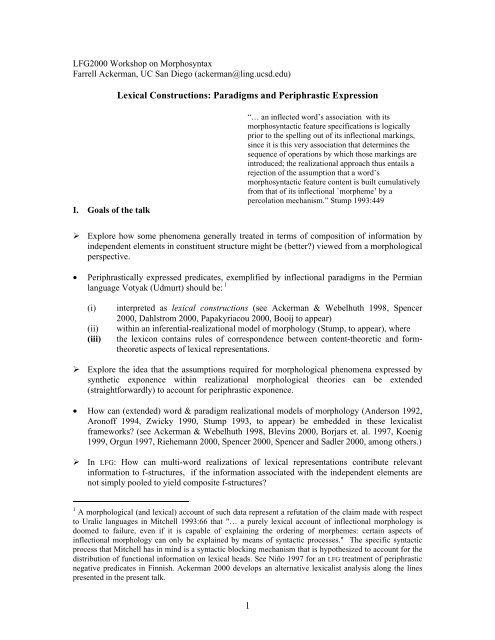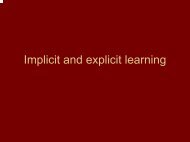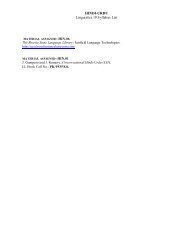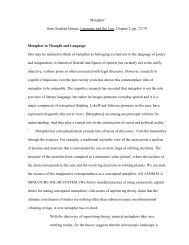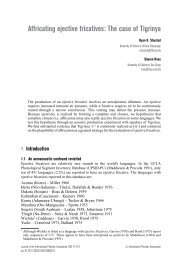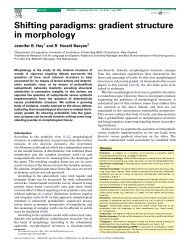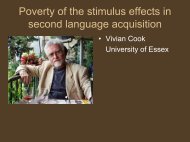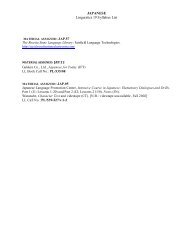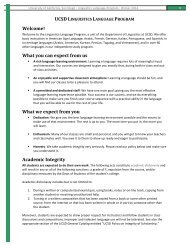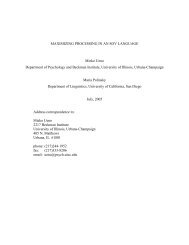Paradigms and Periphrastic Expression - Linguistics - UC San Diego
Paradigms and Periphrastic Expression - Linguistics - UC San Diego
Paradigms and Periphrastic Expression - Linguistics - UC San Diego
You also want an ePaper? Increase the reach of your titles
YUMPU automatically turns print PDFs into web optimized ePapers that Google loves.
LFG2000 Workshop on Morphosyntax<br />
Farrell Ackerman, <strong>UC</strong> <strong>San</strong> <strong>Diego</strong> (ackerman@ling.ucsd.edu)<br />
Lexical Constructions: <strong>Paradigms</strong> <strong>and</strong> <strong>Periphrastic</strong> <strong>Expression</strong><br />
I. Goals of the talk<br />
“… an inflected word’s association with its<br />
morphosyntactic feature specifications is logically<br />
prior to the spelling out of its inflectional markings,<br />
since it is this very association that determines the<br />
sequence of operations by which those markings are<br />
introduced; the realizational approach thus entails a<br />
rejection of the assumption that a word’s<br />
morphosyntactic feature content is built cumulatively<br />
from that of its inflectional `morpheme’ by a<br />
percolation mechanism.” Stump 1993:449<br />
À Explore how some phenomena generally treated in terms of composition of information by<br />
independent elements in constituent structure might be (better?) viewed from a morphological<br />
perspective.<br />
• <strong>Periphrastic</strong>ally expressed predicates, exemplified by inflectional paradigms in the Permian<br />
language Votyak (Udmurt) should be: 1<br />
(i)<br />
(ii)<br />
(iii)<br />
interpreted as lexical constructions (see Ackerman & Webelhuth 1998, Spencer<br />
2000, Dahlstrom 2000, Papakyriacou 2000, Booij to appear)<br />
within an inferential-realizational model of morphology (Stump, to appear), where<br />
the lexicon contains rules of correspondence between content-theoretic <strong>and</strong> formtheoretic<br />
aspects of lexical representations.<br />
À Explore the idea that the assumptions required for morphological phenomena expressed by<br />
synthetic exponence within realizational morphological theories can be extended<br />
(straightforwardly) to account for periphrastic exponence.<br />
• How can (extended) word & paradigm realizational models of morphology (Anderson 1992,<br />
Aronoff 1994, Zwicky 1990, Stump 1993, to appear) be embedded in these lexicalist<br />
frameworks? (see Ackerman & Webelhuth 1998, Blevins 2000, Borjars et. al. 1997, Koenig<br />
1999, Orgun 1997, Riehemann 2000, Spencer 2000, Spencer <strong>and</strong> Sadler 2000, among others.)<br />
À In LFG: How can multi-word realizations of lexical representations contribute relevant<br />
information to f-structures, if the information associated with the independent elements are<br />
not simply pooled to yield composite f-structures?<br />
1 A morphological (<strong>and</strong> lexical) account of such data represent a refutation of the claim made with respect<br />
to Uralic languages in Mitchell 1993:66 that "… a purely lexical account of inflectional morphology is<br />
doomed to failure, even if it is capable of explaining the ordering of morphemes: certain aspects of<br />
inflectional morphology can only be explained by means of syntactic processes." The specific syntactic<br />
process that Mitchell has in mind is a syntactic blocking mechanism that is hypothesized to account for the<br />
distribution of functional information on lexical heads. See NiZo 1997 for an LFG treatment of periphrastic<br />
negative predicates in Finnish. Ackerman 2000 develops an alternative lexicalist analysis along the lines<br />
presented in the present talk.<br />
1
II. Introductory Issues<br />
1. Morphology <strong>and</strong> Lexicalism: A seminal insight <strong>and</strong> a seminal confusion<br />
• Seminal insight of the realizational literature: representations of LEXEMIC <strong>and</strong><br />
morphosyntactic information are independent of their surface exponence (= morphosyntactic<br />
or grammatical word <strong>and</strong> its formal exponence). 2<br />
• Goal: establish the principles of correspondence between the grammatical word <strong>and</strong> its<br />
formal exponence.<br />
Information types associated with lexical representations of predicates:<br />
CORRESPONDENCE<br />
The C(-ontent)-theoretic Aspect Ç-------------È The F(-orm)-theoretic Aspect<br />
-Functional-semantic content: basic meaning, - Morphophonological form(s)<br />
semantic roles, grammatical functions,<br />
subcategorization…<br />
-Morphosyntactic content: tense, aspect, polarity,<br />
agreement, etc.; ( ≈ cells in a paradigm)<br />
• Seminal confusion in the lexicalist literature - Lexical Integrity as a conflation of two notions<br />
(Bresnan & Mchombo 1995, Ackerman & LeSourd 1997, Ackerman & Webelhuth<br />
1998):<br />
Morphological Integrity:<br />
Syntactic mechanisms neither make reference to the daughters of morphological<br />
words nor can they create new morphological words in constituent structure.<br />
Morphological <strong>Expression</strong>:<br />
Lexical entries (lexical representations) are only realized by synthetic word forms, not<br />
multiple syntactically independent elements. 3<br />
2. General Hypothesis: Syntax as morphological exponence<br />
• Some independent <strong>and</strong> co-occurring syntactic pieces are simply exponents or realizations of<br />
the lexemic <strong>and</strong> morphosyntactic information associated with the contentive aspect of lexical<br />
representations.<br />
• The information jointly associated with some independent syntactic pieces is not the result of<br />
composition operations applying when these elements co-occur in constituent structure, but<br />
such information is associated with the relevant forms in the lexical component. (see<br />
epigram)<br />
• Syntactic principles of constituency <strong>and</strong> linearity determine the distribution of these elements.<br />
2 See Beard 1995 Chapter 1 for a brief history of this view <strong>and</strong> Matthews 1993 for an extended comparison<br />
of this view with predominent structuralist (including st<strong>and</strong>ard generativist) assumptions.<br />
3 Of course, I am excluding true idioms from this characterization.<br />
2
3. An example of syntax as morphological exponence in nominals: dual declension of nominals<br />
for local case relations in Tundra Nenets uses an appropriately case inflected postposition<br />
nya- ‘at’. (following Salminen 1997 & p.c.)<br />
ti ‘reindeer’ Singular Dual Plural<br />
Grammatical Case:<br />
nominative ti tex°h tiq<br />
accusative tim tex°h tR<br />
genitive tih tex°h tRq<br />
Local Case:<br />
dative ten°h [tex°h nyah] PP tex°q<br />
locative tex°na [tex°h nyana ] PP tex°qna<br />
ablative texød° [tex°h nyad° ] PP texøt°<br />
prosecutive tew°na [tex°h nyamna] PP teqm°<br />
Table 1<br />
• Morphosyntactic properties for Tundra Nenets nominal lexemes: NUMBER, CASE<br />
• A nominal lexeme L with feature values [NUMBER: dual], [CASE: ] has<br />
the exponence genitive stem form of L + αcase form of nya.<br />
• the exponence shows the syntactic distribution <strong>and</strong> behavior of postpositional phrases.<br />
4. Hypothesis of syntax as morphological exponence for predicates<br />
• Some independent syntactic <strong>and</strong> co-occurring pieces are simply exponents of lexical<br />
representations for (complex) predicates, just as occurs with the synthetic expression of<br />
predicates.<br />
5. What sorts of criteria may be useful in determining which syntactic expressions are<br />
morphological?<br />
• Family of Constructional Effects – Contentive information (i.e., lexical <strong>and</strong><br />
morphosyntactic) associated with the predicate is not a straightforward product of<br />
information from formal pieces (unless large degree of homophony, synonymy, or covert<br />
categories is permitted).<br />
• Family of Paradigm Effects – Access to morphosyntactic cell information is crucial for<br />
insightful analysis. Morphosyntactic information distinctions found in one paradigm are<br />
introduced throughout a related paradigm. Paradigmatic features relevant to synthetic<br />
expression are also relevant to periphrastic expression: this is what it means to claim that<br />
periphrastic forms participate in morphological paradigms.<br />
3
II. <strong>Paradigms</strong> for predicates: Morphosyntax <strong>and</strong> exponence in the Permian language<br />
Votyak (Udmurt) - Word Order: SUBJ OBJ PREDICATE; [ (NEG) V (COP) predicate ]<br />
6. What are the morphosyntactic paradigm categories for verbal lexemes in Votyak? 4<br />
• {[PERSON: 1, 2, 3], [NUMBER: sg, pl], [TENSE: present, continutive past, future, imperfective<br />
past, 1 st past, 2 nd past (=perfect), …], [MOOD: indicative, imperative, narrative (=<br />
inferential)..], [POLARITY: affirmative, negative]} - (following Suihkonen 1996)<br />
7. Diachronic development of person/number marking for negative polarity:<br />
À Reconstructed paradigms for affirmative (Serebrennikov 1963:235 5 ) <strong>and</strong> negative<br />
(Serebrennikov 1963:287) present tense of Proto-Permian mγnγ - `go':<br />
7A. [POL:aff], [TNS:present]: [POL:neg], [TNS:present]:<br />
SG.1. mγnam `I am going' SG.1. om mγnγ 6 `I am not going'<br />
2. mγnad 2. ot mγnγ<br />
3. mγna 3. ok mγnγ<br />
PL.1. mγnamV PL.1. om mγnγ<br />
2. mγnadV 2. ot mγnγ<br />
3. mγnazV 3. ok mγnγ<br />
• Distinctive marking for person & number in affirmative present tense.<br />
• Only person distinctions in negative present tense.<br />
• Invariant connegative forms. 7<br />
4 Suihkonen 1995:298 writes: "The categories occurring in verbal conjugation are person, tense, mood,<br />
negation…" This is a restatement of the relevant categories for verbal paradigms found in Suihkonen<br />
190:95.<br />
5 γ is a diacritic used by Serebrennikov to indicate variable quality for a vowel.<br />
6 The paradigms will reveal a large amount of syncretrism in the actual forms used to express<br />
morphosyntactic features, but I will ignore for the most part the actual realizational rules <strong>and</strong> associated<br />
systematicities of form, focusing simply on synthetic versus periphrastic expresssion. I assume that<br />
something on the order of rules of referral need to be formulated here (see Zwicky 1990, Stump 1993, to<br />
appear.<br />
7 Invariance of the connegative (with respect to number in the present tense) still exists in numerous Finnic<br />
languages, e.g., Finnish en lue `I’m not reading.’ & emme lue `We’re not reading.’ (see Serebrennikov<br />
1964:140).<br />
4
À <strong>Paradigms</strong> of 1 st conjugation predicates exemplified by mVnV ‘go’ in Votyak: (following Csucs<br />
1998:290, but see Csucs 1990:51 <strong>and</strong> Serebrennikov 1963 for alternative transcriptions) 8<br />
7B. [POL:aff], [TNS:present]: [POL:neg], [TNS:present]:<br />
SG.1. mVni» j ko 9 ‘I am going’ SG.1. ug mVni» j kV ‘I am not going’<br />
2. mVni» j kod 2. ud mVni» j kV<br />
3. mVne 3. ug mVnV<br />
PL.1. mVni» j kom(V) PL. 1. um mVni» j ke<br />
2. mVni» j kodV 2. ud mVni» j ke<br />
3. mVno 3. ug mVno<br />
• Distinctions between person & number in affirmative present tense (as in P-Permian)<br />
• Person & number marking in negative present tense with number reflected in<br />
connegative forms (different from P-Permian)<br />
• Syncretism among forms for person in negative present tense, i.e., ug = 1 st sg. & 3 rd .<br />
• (Word stress on initial syllable in connegative form, but on final syllable in<br />
affirmative form. (see below))<br />
8. Some Paradigm Effects:<br />
• Introduction of person/number distinction for SUBJ agreement over the pieces of the<br />
periphrastic negative predicate (7B), yielding the person/number distinction for SUBJ<br />
agreement reflected in synthetic expressions of predicates, i.e., the periphrastic<br />
expression realizes the same morphosyntactic distinctions as synthetic expressions.<br />
• Preservation of certain aspects of stem form across polarity in (7B), i.e., -» j k for 1 st <strong>and</strong> 2 nd<br />
person, mVn- for 3 rd person, <strong>and</strong> mVno for 3 rd plural.<br />
9. Constructional Effect:<br />
• Form ug in (7B) is not determinate for person (except -2 nd ) <strong>and</strong> mVni» j kV while<br />
determinate for singular number is not determinate for person (except -3 rd );<br />
• the construction ug mVni» j kV is realization of the morphosyntactic feature set {[POL:neg],<br />
[TNS:present], [PERS:1 ST ], [NUM: sg]}, where its distinctiveness is defined relative to<br />
realizations of others cells in the paradigm.<br />
À A verbal lexeme L with feature values [POL:aff], [TNS:present], [PERS: ],<br />
[NUM: ] has synthetic exponence.<br />
À A verbal lexeme L with feature values [POL:neg], [TNS:present], [PERS: ],<br />
[NUM: ] has periphrastic exponence.<br />
8 Following Csucs 1998 underlining in the examples indicates primary stress, when this occurs in initial<br />
syllables. There is a striking amount of syncretism among the form within these paradigms much of which<br />
will be ignored for present purposes.<br />
9 -o in these forms is reconstructed as a reflex of the original present tense marker –a evident in the proto-<br />
Permian forms in 7A <strong>and</strong> still extant for the 1 st <strong>and</strong> 2 nd persons in the closely related language Komi.<br />
Serebrennikov 1964:92 suggests that –»k in 1 st <strong>and</strong> 2 nd person is a secondary present tense marker derived<br />
from the Uralic frequentative marker. Thus, synchronically, there are two present tense markers in the<br />
forms for 1 st <strong>and</strong> 2 nd person.<br />
5
10. Future tense: Reinterpretation of Proto-Permian present as future<br />
C. [POL:aff], [TNS: future]: [POL:neg], [TNS: future]:<br />
SG.1. mVno ‘I will go’ SG.1. ug mVnV ‘I will not go’<br />
2. mVnod 2. ud mVnV<br />
3. mVnoz 3. uz mVnV<br />
PL.1 mVnom(V) PL.1 um mVne(le)<br />
2. mVnodV 2. ud mVne(le)<br />
3. mVnozV 3. uz mVne(le)<br />
11. Paradigm Effect:<br />
• Regularization of person marking distinction within negative future, reflecting regular<br />
distinctions in affirmative paradigms.<br />
• Distinctive person marking on negative verb <strong>and</strong> number marking on connegative form<br />
yields distinctive person/number for SUBJ predicate agreement over the pieces of<br />
periphrastic predicate, making it resemble more clearly the distinctive marking for<br />
person/number in affirmative paradigms with synthetic expression.<br />
À A verbal lexeme L with feature values [POL:aff], [TNS:future], [PERS: ],<br />
[NUM: ] has synthetic exponence.<br />
À A verbal lexeme L with feature values [POL:neg], [TNS:future], [PERS: ],<br />
[NUM: ] has periphrastic exponence.<br />
12. Imperatives: All of the connegative forms in the preceding negative paradigms have initial<br />
syllable stress, despite the fact that only certain forms are segmentally identical to<br />
imperatives.<br />
D. [POL:aff], [MOOD: imperative]: [POL:aff], [MOOD: imperative]:<br />
SG.2. mVn(V) SG.2 en mVnV<br />
3. med mVnoz 3. medaz mVnV<br />
PL.2 mVne(le) PL.2 en mVne(le)<br />
3. med mVnozV 3. medaz mVne(le)<br />
• Negative future has same singular <strong>and</strong> plural forms as imperative 2 nd singular <strong>and</strong> plural<br />
forms <strong>and</strong>,<br />
• same syllable initial stress.<br />
• Negative present has only same 3 rd singular form as imperative 2 nd singular but,<br />
• negative present, as well as all other connegative forms for all paradigms, exhibits<br />
syllable initial stress on connegative form as in imperatives.<br />
• Thus, the stress pattern associated with imperatives (<strong>and</strong> otherwise not associated with<br />
verb forms) is characteristic of connegative forms when there is periphrastic exponence<br />
for [POL:neg].<br />
6
13. Compound tenses consist of forms from either the present or future <strong>and</strong> an invariant 1 st past<br />
form of the copula or an invariant perfect form of the copula (narrative or inferential):<br />
“These compound forms express a protracted or repeated activity occurring in the past or<br />
distant past.” – Csucs 1990:51<br />
14. Continuitive past tense: combination of form from present tense paradigm <strong>and</strong> invariant 1 st<br />
past form of copula: 10<br />
“In Permian, Mari, <strong>and</strong> Morvdin there is an emphatic protracted past tense. It is used<br />
in those situations, when the speaker wants to especially pick out <strong>and</strong> emphasize some<br />
sort of protracted activity being accomplished in the past.” Serebrennikov 1964:114.<br />
E. [POL:aff], [TNS: cont. past]: [POL:neg], [TNS: cont. past]:<br />
SG.1. mVni» j ko val `I was going' SG.1. ug mVni» j kV val `I wasn’t going'<br />
2. mVni» j kod val 2. ud mVni» j kV val<br />
3. mVne val `s/he was going' 3. ug mVnV val `s/he wasn’t going'<br />
PL.1. mVni» j kom(V) val PL. 1. um mVni» j ke val<br />
2. mVni» j kodV val 2. ud mVni» j ke val<br />
3. mVno val 3. ug mVno val<br />
15. Paradigm effect:<br />
• The full set of forms from present tense paradigm is used in the continuitive past tense<br />
paradigm for the indication of person/number.<br />
10 Although the actual interpretation of this feature set is still unclear to me, I follow the characterization of<br />
Serebrennikov 1963:271 <strong>and</strong> 1960:126 in terms of his analogy of this tense, which he refers to as dlitelnoe<br />
vreme `protracted time’, with the use of the Russian particle byvalo `it happened'. He suggests that it has<br />
uses analogous to the English past continuous <strong>and</strong> provides analogues with Finnish progressive<br />
constructions consisting of a present or past copula inflected for person & number <strong>and</strong> a 3 rd infinitival<br />
inessive form of the verb, e.g., olen/olin kirjoittamassa `I am/was writing.’ (Serebrennikov 1964:115). He<br />
also observes that this tense finds a parallel in the verbal paradigm of the related language Mordvin, where<br />
it is realized synthetically in contrast to its periphrastic exponence in Votyak: descriptions of this tense<br />
feature in Mordvin sometimes translate it as a past habitual (see KeresztJs 1990:41). It is worth noting in<br />
the present context, i.e., where a present form of the verb co-occurs with a past form yielding a periphrastic<br />
expression in Votyak, that the synthetic expression in Mordvin consists of a present active participle <strong>and</strong><br />
the suffixed remainder of the past form of the copula inflected for person <strong>and</strong> number, the two elements<br />
synchronically forming a single synthetic wordform. (Serebrennikov 1964:115) See also Suihkonen<br />
1995:302 where this tense in Votyak is designated Continuitive Past. These observations might suggest<br />
that what is called the present tense is better analyzed as progressive aspect: thus such forms co-occurring<br />
with a past copular form might compositionally yield past progressive. On the other h<strong>and</strong>, his would yield<br />
a tense system containing a future (see below), but no present. In addition, a progressive construal would<br />
be hard to reconcile when this paradigm is used for statives (i) or non-progressive uses of activity verbs:<br />
(i) TodmatskemmVlV »umpoti¹ko. (ii) Udmurt ¹amen vera¹ki¹kod-a?<br />
acquaintence-DAT-1PL/POSS glad-1SG/PRES udmurt according to speak-2SG-Q<br />
`I'm glad we've become acquainted.' `Do you speak Udmurt?'<br />
(Csucs 1990:70) (Csucs 1990:68)<br />
7
16. Constructional effect:<br />
• The present tense form cannot bear the feature [TNS:present], since the whole<br />
construction is past.<br />
À A verbal lexeme L with feature values [POL:aff], [TNS: cont. past], [PERS: ],<br />
[NUM: ] has periphrastic exponence.<br />
À A verbal lexeme L with feature values [POL:neg], [TNS: cont. past], [PERS: ], [NUM: ] has periphrastic exponence<br />
17. Imperfective past: combination of form from future tense paradigm <strong>and</strong> invariant past form of<br />
copula. 11<br />
F. [POL:aff], [TNS: imp. past]: [POL:neg], [TNS: imp. past]:<br />
SG.1. mVno val SG.1. ug mVnV val<br />
2. mVnod val 2. ud mVnV val<br />
3. mVnoz val ‘s/he used to 3. uz mVnV val ‘s/he didn’t used to<br />
go (long time ago)’ go (long time ago)’<br />
PL.1 mVnom(V) val PL.1 um mVne(le) val<br />
2. mVnodV val 2. ud mVne(le) val<br />
3. mVnozV val 3. uz mVne(le) val<br />
18. Paradigm effect:<br />
• The full set of forms from future tense paradigm is used in the imperfective past tense<br />
paradigm for the indication of person/number.<br />
19. Constructional effect:<br />
• The future tense form cannot bear the feature [TNS:future], since the whole construction<br />
is past.<br />
• Neither of the forms in the construction are associated with a habitual sense or ‘long ago’,<br />
independent of this construction.<br />
• Neither of the forms in the continuitive past (=14) are associated with `recent past’<br />
relative to distant past associated with imperfective past.<br />
11 The semantics of this tense too requires further investigation: Suihkonen 1995:302 designates it as<br />
"iterative". The difference between the continuitive past (= 14) <strong>and</strong> the imperfective past (=17) appears to<br />
be the relative time in the past when a protracted or repeated event occurred, specifically, relatively<br />
recently (<strong>and</strong> not necessarily repeated) with the continuative <strong>and</strong> a long time ago with the imperfective. If<br />
something like this is correct, then the relative times would have to be keyed to the inflecting verbs, since<br />
the copulas are invariant in both constructions. This suggests that both present <strong>and</strong> future might be best<br />
interpreted as indicating reference points relative to an established time: when the default is the so-called<br />
"present" there is no overt marker <strong>and</strong> the present form indicates greater closeness to the present than the<br />
"future". When a past time is established by the presence of the copula, then the "present" form indicates<br />
greater closeness to a time in the past, while the "future" indicates greater distance from that time. This<br />
speculative hypothesis needs further examination.<br />
8
À A verbal lexeme L with feature values [POL:aff], [TNS: imp. past], [PERS: ],<br />
[NUM: ] has periphrastic exponence.<br />
À A verbal lexeme L with feature values [POL:neg], [TNS: imp. past], [PERS: ], [NUM: ] has periphrastic exponence.<br />
20. Challenge posed by syncretistic forms:<br />
• Since e.g., mVno is segmentally 3 rd PL PRESENT <strong>and</strong> CONTINUITIVE PAST AFFIRMATIVE <strong>and</strong><br />
NEGATIVE as well as, <strong>and</strong><br />
• 1 st SG FUTURE <strong>and</strong> imperfective past, <strong>and</strong><br />
• Suprasegmentally patterns with imperatives,<br />
• what is the empirically verifiable morphemic composition of this form?<br />
21. Continuitive past tense narrative (inferential/non-witnessed): combination of form from<br />
present tense paradigm <strong>and</strong> invariant 2 nd past (=perfect) form of copula: 12<br />
G. [POL:aff], [TNS: cont. past], [MOOD: narr]: [POL:neg], [TNS: cont. past] [MOOD: narr]:<br />
SG.1. mVni» j ko vVlem SG.1. ug mVni» j kV vVlem<br />
2. mVni» j kod vVlem 2. ud mVni» j kV vVlem<br />
3. mVne vVlem ‘s/he was going’ 3. ug mVnV vVlem `s/he wasn’t<br />
(they say)<br />
going'(they say)<br />
PL.1. mVni» j kom(V) vVlem PL. 1. um mVni» j ke vVlem<br />
2. mVni» j kodV vVlem 2. ud mVni» j ke vVlem<br />
3. mVno vVlem 3. ug mVno vVlem<br />
22. Paradigm effect:<br />
• The present tense form cannot bear the feature [TNS:present], since the whole<br />
construction is past. (= same as for 14)<br />
• Perfect form associated with narrative mood for verbal lexeme, irrespective of<br />
periphrastic or synthetic expression (see below).<br />
23. Constructional effect: same as for (10).<br />
À A verbal lexeme L with feature values [POL:aff], [TNS:present], [MOOD:narr], [PERS: ], [NUM: ] has periphrastic exponence.<br />
À A verbal lexeme L with feature values [POL:neg], [TNS:present], [MOOD:narr], [PERS: ], [NUM: ] has periphrastic exponence.<br />
12<br />
In general the relation between compound tense meanings <strong>and</strong> the forms used to convey them would<br />
seem to raise questions concerning analyses in which co-occurring elements in syntax compositionally<br />
combine their information. Questions are raised concerning the morphosyntactic features associated with<br />
words, their semantic interpretation, <strong>and</strong> the semantic interpretation of whole feature set combinations.<br />
(See Haliday <strong>and</strong> Hasan 1976:186 for interesting data from English.)<br />
9
24. 2 nd past tense ( = perfect): perfect participle optionally inflected for person/number with<br />
markers from possessive paradigm <strong>and</strong> both affirmative <strong>and</strong> negative expressed synthetically.<br />
13<br />
H. [POL:aff], [TNS: 2 nd past], [MOOD:narrative]: [POL:neg], [TNS: 2 nd past], [MOOD:narrative]<br />
SG.1. mVni» j kem SG.1. mVni» j kVmte(je)<br />
2. mVnem(ed) 2. mVnVmtejed<br />
3. mVnem(ez) ‘s/he went (they say)’ 3. mVnVmte(jez) ‘s/he didn’t go (they say)’<br />
PL.1 mVni» j kemmV PL.1. mVni¹ j kVmtemV<br />
2. mVnil j l j am(dV) 14 2. mVnil’l’amte(dV)<br />
3. minil j l j am(zV) 3. mVnil j l j amte(zV)<br />
25. Paradigm effects:<br />
• 1 st person stem in both affirmative <strong>and</strong> negative is mVni» j k-, similar to present tense stem.<br />
• Since the perfect participle is interpreted as a finite predicate, it participates in a<br />
SUBJ/PREDICATE agreement paradigm, as do all predicates. 15<br />
À A verbal lexeme L with feature values [POL:aff], [TNS: 2 nd past], [MOOD:narrative], [PERS:<br />
], [NUM: ] has synthetic exponence.<br />
À A verbal lexeme L with feature values [POL:neg], [TNS: 2 nd past], [MOOD:narrative], [PERS:<br />
], [NUM: ] has synthetic exponence.<br />
IV. Conclusions<br />
• Formal exponence, ie., spell-outs, whether synthetic or periphrastic, appear to be keyed to<br />
morphosyntactic feature sets defining particular paradigms.<br />
13 There is an alternative periphrastic expression of this past <strong>and</strong> polarity combination which will be<br />
ignored here. Synthetic expression is claimed to occur in the literary language <strong>and</strong> to derive from southern<br />
dialects, while periphrastic expression is associated with northern dialects. (see Teplja»ina & Lytkin<br />
1976:180.)<br />
14 According to Serebrennikov 1963:264, the stem forms in the 2 nd <strong>and</strong> 3 rd plural represent innovations<br />
containing a presumptive distributive aspect marker -il j l j a suffixed to the root mVn-: the 2 nd <strong>and</strong> 3 rd original<br />
plural forms resembled the 2 nd <strong>and</strong> 3 rd singulars <strong>and</strong> were mVnem(ed) <strong>and</strong> mVnem(zV), respectively. The<br />
original pattern of verbal root + perfect marker + possessive marker exists for all person/number<br />
combinations in the language most closely related to Votyak, namely, Komi (see RJdei 1978:81). In<br />
western Uralic the perfect is generally realized analytically by means of a past participle <strong>and</strong> present tense<br />
form of the copula inflected for person/number, while in eastern Uralic (as above) there is synthetic<br />
realization using a perfect participle inflected for person/number.<br />
15 The fact that markers from the possessive paradigm are used for subject/predicate agreement, in this<br />
tense presumably reflects the status of the perfective forms as adjectives <strong>and</strong> nominals: this categorial status<br />
also explains why it is possible to have synthetic negative variants with the suffix -mte which otherwise<br />
combine with both infinitives <strong>and</strong> perfect participles functioning as adjectives.<br />
10
• When the predicates of Votyak are analyzed as lexical constructions, i.e., as lexical<br />
representations in which paradigmatically contrasting morphosyntactic feature sets have<br />
specific realizations, then,<br />
• <strong>Periphrastic</strong> syntactic expression appears to be a type of morphological exponence.<br />
References 16<br />
Ackerman, F. 2000. Permian morphosyntax: a view from the lexicon. Ms. <strong>UC</strong> <strong>San</strong> <strong>Diego</strong>.<br />
Ackerman F. & G. Webelhuth. 1998. A Theory of Predicates. CSLI Publications.<br />
Ackerman F. & P. LeSourd. 1997. Toward a lexical representation of phrasal predicates<br />
In A. Alsina, et.al. eds. Complex Predicates. CSLI Publications.<br />
Anderson. S. 1992. A-morphous Morphology. Cambridge University Press.<br />
Aronoff. M. 1994. Morphology by Itself. MIT Press.<br />
Beard, R. 1995. Lexeme-morpheme base morphology. State University of New York Press.<br />
Blevins, J. 2000. Lexemic stems in Western Germanic. Ms. Cambridge University.<br />
Booij, G. 2000. The diachrony of complex predicates in the West Germanic languages. Grant<br />
Proposal funded by the Dutch Organization for Scientific Research.<br />
Börjars, K. N. Vincent, <strong>and</strong> C. Chapman. 1997. <strong>Paradigms</strong>, periphrases <strong>and</strong> pronominal<br />
inflection: a feature-based account. In Geert Booij <strong>and</strong> Jaap van Marle (eds.) Yearbook of<br />
Morphology 1996, Dordrecht: Kluwer Academic Publishers, 155-180.<br />
Bresnan & Mchombo 1995. The lexical integrity principle: Evidence from Bantu.<br />
Natural Language <strong>and</strong> Linguistic Theory 13.2, 181-254.<br />
Csucs, S. 1998. Udmurt. In D. Abondolo ed. The Uralic Languages. Routledge.<br />
Csucs, S. 1990. Chrestomathia Votiacica. Tank`nyvkiad\. Budapest.<br />
Halliday, M.A.K. & R. Hasan. Cohesion in English. Longman.<br />
KeresztJs, L. 1990. Chrestomathia Morduinica. Tank`nyvkiad\. Budapest.<br />
Koenig, J-P. 1999. Lexical Relations. CSLI Publications.<br />
Matthews, P.H. 1993. Grammatical theory in the United States from Bloomfield to Chomsky.<br />
Cambridge University Press.<br />
Mitchell, E. 1993. Morphological evidence for syntactic structure: the Finno-Ugric languages <strong>and</strong><br />
English. PhD. dissertation, Cornell University.<br />
NiZo. M. E. 1997. Split inflection <strong>and</strong> the architecture of grammar. Ms. Stanford University.<br />
Orgun, O. 1996. Sign-based morphology <strong>and</strong> phonology with special attention to Opimality<br />
Theory. PhD. dissertation, <strong>UC</strong> Berkeley.<br />
Papakyriacou, A. Aspektuelle Verben als komplexe Prädikate. Ms. Humboldt-Universität, Berlin.<br />
Riehemann, S. 2000. Type-Based Derivational Morphology. Journal of Comparative Germanic<br />
<strong>Linguistics</strong> 2: 49-77.<br />
Salminen, Tapani. 1997. Tundra Nenets inflection. Suomalias-Ugrilainen Seura. Helsinki.<br />
Serebrennikov, V. A. 1964. Osnovye linii razvitija padeÙnoj I glagolnoj sistem v uralskix<br />
jazykax. Moscow.<br />
Serebrennikov, V. A. 1963. Istoriûeskaja morfologia Permskix jazykovi. Akademii Nauk.<br />
Serebrennikov, V. A. 1960. Kategorii vremeni i vida v finno-ugorskix jazykax permskoj I volÙkoj<br />
Grup. Moscow.<br />
Spencer, A. 2000. The word <strong>and</strong> paradigm model of morphosyntax. Ms. University of Essex.<br />
Spencer, A. <strong>and</strong> Sadler, L. 2000. Syntax as an exponent of morphological features. Ms.<br />
University of Essex.<br />
16 I would like to express appreciation to the following colleagues <strong>and</strong> friends for critical comments <strong>and</strong><br />
help on drafts of this talk: Chris Barker, Eric Bakoviü, Jim Blevins, Mark Gawron, Andy Kehler, Yuki<br />
Kuroda, John Moore, Sharon Rose, Andy Spencer, Tapani Salminen, Gert Webelhuth.<br />
11
Stump. G. to appear. Inflectional Morphology: A Theory of Paradigm Structure. Cambridge<br />
University Press.<br />
Stump, G. 1993. Rules of referral. Language 69.3:449-479.<br />
Suihkonen, P. 1995. Udmurt-English-Finnish Dictionary with basic grammar of Udmurt<br />
Suomalias-Ugrilainen Seura. Helsinki.<br />
Suihkonen, P. 1990. Korpustustutkimus keilitypolgiassa sovellettuna Udmurtin. Suomalias-<br />
Ugrilainen Seura, Helsinki.<br />
Teplja»ina, T. & Lytkin, V. 1976. Permiskie jazyki. In Maitinksaja, K. et.al. eds. Osnovy<br />
Finno-Ugorskogo Jazykoznanie. Moscow.<br />
Vainikka 1989. Deriving syntactic representations in Finnish. PhD. dissertation,<br />
University of Massachusetts, Amherst.<br />
Zwicky, A. 1990. Systematic versus accidental phonological identity. In F. Plank. ed.<br />
<strong>Paradigms</strong>: The Economy of Inflection. Mouton de Gruyter. 113-131.<br />
12


